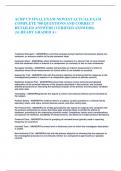ACRP CP FINAL EXAM NEWEST ACTUAL EXAM
COMPLETE 700 QUESTIONS AND CORRECT
DETAILED ANSWERS (VERIFIED ANSWERS)
|ALREADY GRADED A+
Treatment Emergent - ANSWERAn event that emerges during treatment having been absent pre-
treatment, or worsens relative to the pre-treatment state.
treatment effect - ANSWERAn effect attributed to a treatment in a clinical trial. In most clinical
trials the treatment effect of interest is a comparison (or contrast) of two or more treatments.
Surrogate Variable - ANSWERA variable that provides an indirect measurement of effect in
situations where direct measurement of clinical effect is not feasible or practical.
Superiority Trial - ANSWERA trial with the primary objective of showing that the response to the
investigational product is superior to a comparative agent (active or placebo control).
Statistical Analysis Plan - ANSWERDocument that contains a more technical and detailed
elaboration of the principal features of the analysis described in the protocol, and includes
detailed procedures for executing the statistical analysis of the primary and secondary variables
and other data.
Tolerability - ANSWERRepresents the degree to which overt adverse effects can be tolerated by
the subject.
Product Safety - ANSWERThe medical risks to a subject, usually assessed in a clinical trial by
laboratory tests, vital signs, clinical adverse events, and other safety tests.
Per Protocol Set - ANSWERA set of data generated by the subset of subjects who complied with
the protocol sufficiently to ensure that these data would be likely to exhibit the effects of
treatment, according to the underlying scientific model. Compliance covers such considerations
as exposure to treatment, availability of measurements, and absence of major protocol deviations.
Preferred Term - ANSWERThe level of grouping of included terms typically used in reporting
frequency of occurance.
Included Term - ANSWERThe lowest level of dictionary term to which the investigator description
is coded.
Non-inferiority Trial - ANSWERA trial with the primary objective of showing that the response to
the investigational product is not clinically inferior to a comparative agent (active or placebo
control).
,Multicenter Trial - ANSWERA clinical trial conducted according to a single protocol but at more
than one site, and therefore, carried out by more than one investigator.
Meta-Analysis - ANSWERA formal evaluation of the quantitative evidence from two or more trials
bearing on the same question
Interim Analysis - ANSWERany analysis intended to compare treatment arms with respect to
efficacy or safety at any time prior to the formal completion of a trial
Intra-rater reliability - ANSWERThe property of yielding equivalent results when used by the same
rater on different occasions
inter-rater reliability - ANSWERThe property of yielding equivalent results when used by different
raters on different occasions.
Qualitative interaction - ANSWERthe direction of the contrast differs for at least one level of the
factor
Quantitative Interaction - ANSWERThe magnitude of the contrast differs at the different levels of
the factor
Intention-To-Treat Principle - ANSWERThe principle that asserts that the effect of a treatment
policy can be best assessed by evaluating on the basis of the intention to treat a subject (i.e. the
planned treatment regimen) rather than the actual treatment given. It has the consequence that
subjects allocated to a treatment group should be followed up, assessed and analysed as
members of that group irrespective of their compliance to the planned course of treatment.
Bayesian Approaches - ANSWERApproaches to data analysis that provide a posterior probability
distribution for some parameter (e.g. treatment effect), derived from the observed data and a prior
probability distribution for the parameter. The posterior distribution is then used as the basis for
statistical inference.
Blind Review - ANSWERThe checking and assessment of data during the period of time between
trial completion (the last observation on the last subject) and the breaking of the blind, for the
purpose of finalising the planned analysis.
Content Validity - ANSWERThe extent to which a variable (e.g. a rating scale) measures what it is
supposed to measure.
Double-Dummy - ANSWERA technique for retaining the blind when administering supplies in a
clinical trial, when the two treatments cannot be made identical. Supplies are prepared for
Treatment A (active and indistinguishable placebo) and for Treatment B (active and
indistinguishable placebo). Subjects then take two sets of treatment; either A (active) and B
(placebo), or A (placebo) and B (active).
Dropout - ANSWERA subject in a clinical trial who for any reason fails to continue in the trial until
the last visit required of him/her by the study protocol.
Equivalence Trial - ANSWERA trial with the primary objective of showing that the response to two
or more treatments differs by an amount which is clinically unimportant. This is usually
demonstrated by showing that the true treatment difference is likely to lie between a lower and an
upper equivalence margin of clinically acceptable differences.
Frequentist Methods - ANSWERStatistical methods, such as significance tests and confidence
intervals, which can be interpreted in terms of the frequency of certain outcomes occurring in
hypothetical repeated realizations of the same experimental situation.
,Full Analysis Set - ANSWERThe set of subjects that is as close as possible to the ideal implied by
the intention-to-treat principle. It is derived from the set of all randomised subjects by minimal and
justified elimination of subjects.
Generalisability, Generalisation - ANSWERThe extent to which the findings of a clinical trial can
be reliably extrapolated from the subjects who participated in the trial to a broader patient
population and a broader range of clinical settings.
Global Assessment Variable - ANSWERA single variable, usually a scale of ordered categorical
ratings, which integrates objective variables and the investigator's overall impression about the
state or change in state of a subject.
Independent Data Monitoring Committee (IDMC) - ANSWERAn independent data-monitoring
committee that may be established by the sponsor to assess at intervals the progress of a clinical
trial, the safety data, and the critical efficacy endpoints, and to recommend to the sponsor
whether to continue, modify, or stop a trial.
Bias (Statistical & Operational) - ANSWERThe systematic tendency of any factors associated with
the design, conduct, analysis and evaluation of the results of a clinical trial to make the estimate
of a treatment effect deviate from its true value. Bias introduced through deviations in conduct is
referred to as 'operational' bias. The other sources of bias listed above are referred to as
'statistical'.
Adverse Event (or Adverse Experience) - ANSWERAny untoward medical occurrence in a patient
or clinical investigation subject administered a pharmaceutical product and which does not
necessarily have to have a causal relationship with this treatment.
Adverse Drug Reaction (ADR) - ANSWERall noxious and unintended responses to a medicinal
product related to any dose should be considered adverse drug reactions.
Unexpected Adverse Drug Reaction - ANSWERAn adverse reaction, the nature or severity of
which is not consistent with the applicable product information (e.g., Investigator's Brochure for
an unapproved investigational medicinal product).
Applicable Regulatory Requirement(s) - ANSWERAny law(s) and regulation(s) addressing the
conduct of clinical trials of investigational products.
Approval (in relation to Institutional Review Boards) - ANSWERThe affirmative decision of the IRB
that the clinical trial has been reviewed and may be conducted at the institution site within the
constraints set forth by the IRB, the institution, Good Clinical Practice (GCP), and the applicable
regulatory requirements.
Audit - ANSWERA systematic and independent examination of trial related activities and
documents to determine whether the evaluated trial related activities were conducted, and the
data were recorded, analyzed and accurately reported according to the protocol, sponsor's
standard operating procedures (SOPs), Good Clinical Practice (GCP), and the applicable
regulatory requirement(s).
Institution (medical) - ANSWERAny public or private entity or agency or medical or dental facility
where clinical trials are conducted.
The financial aspects of the trial should be documented in an agreement between: - ANSWERthe
sponsor and the investigator/institution
, How long should the IRB/IEC take to review a proposed clinical trial and document its views in
writing? - ANSWERA reasonable time
What are the elements of the risk-based approach of quality management system? -
ANSWERCritical Process and Data Identification, Risk Identification, Risk Evaluation, Risk
Control, Risk Communication, Risk Review, Risk Reporting
Contract Research Organization (CRO) - ANSWERAn individual or an organization (commercial,
academic, or other) contracted by the sponsor to perform one or more of a sponsor's trial-related
duties and functions. This could be data management and/or monitoring.
According to ICH GCP what is addendum in monitoring? - ANSWERMonitoring Plan
According to ICH GCP what is the purpose of updates of medical/laboratory tests? - ANSWERTo
document that tests remain adequate throughout the trial period
According to ICH GCP double blind usually refers to the _________________ being unaware of the
treatment assignment(s). - ANSWERsubject(s), investigator(s), monitor, and, in some cases, data
analyst(s)
ICH GCP states the protocol should generally include stopping rules for individual subjects, parts
of trials and entire trial. What other term does it specify in addition to Stopping Rule? -
ANSWERdiscontinuation criteria
According to ICH GCP Source data should be attributable, legible, contemporaneous, original,
accurate, and complete. Changes to source data should be _____________, should not obscure
the original entry, and should be explained if necessary (e.g., via an audit trail). -
ANSWERTraceable
As per ICH GCP section 4.5 compliance to protocol, the _____________ should document and
explain any deviation from the approved protocol. - ANSWERinvestigator
According to the Monitor\'s Responsibilities section of ICH GCP which of the following should be
clearly reported on the CRF: 1. A visit that subject fails to make 2. Tests that are not conducted 3.
Examinations that are not performed - ANSWERAll three
According to ICH GCP for how long the IRB/IEC should retain all relevant records? - ANSWERFor
a period of at least 3-years after completion of the trial
Where should final trial close-out monitoring report be filed? - ANSWERThe sponsor file only
Where should the audit certificate be filed? - ANSWERThe sponsor file only
During the clinical conduct of the trial where should new batches of certificate of analysis of
investigational product(s) be filed? - ANSWERThe sponsor file only
According to ICH GCP The investigator should be thoroughly familiar with the appropriate use of
the investigational product(s), as described in the: - ANSWERProtocol, investigators brochure,
and in the product information
Which of the following is not in the list given by ICH GCP for the factors guiding the audit plan and
procedures for a trial audit; importance of the trial to submissions to regulatory authorities, the
number of subjects in the trial, the type and complexity of the trial, the level of risks to the trial
subjects, or the duration of treatment for each trial subject? - ANSWERthe duration of treatment
for each trial subject





